Vikings: Warriors of the World
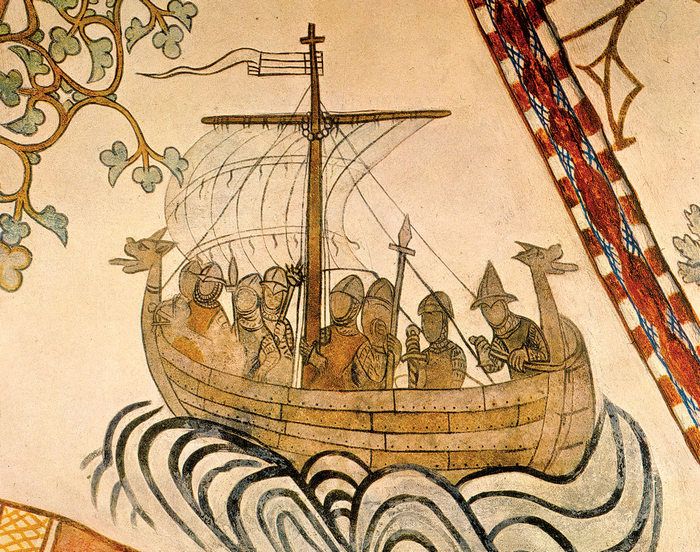
Viking ship carrying Harold III of Norway against his half-brother Olaf II in 1030, c.1375.
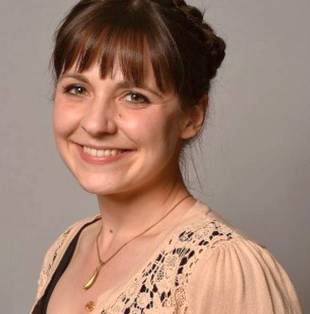
Miscellanies - Eleanor Barraclough | Published 10 April 2019
Norse travellers reached every corner of the known world, but they were not tourists. The ‘racially pure’ Vikings of stereotype were, in fact, cultural chameleons adopting local habits, languages and religions.
In January 2018, President Trump expressed a preference for immigrants from affluent nations such as Norway, as opposed to those from what he termed ‘shithole countries’. The indignant response was on a global scale. Photos of beautiful African sunsets and wildlife were posted. One Norwegian woman tweeted: ‘We are not coming. Cheers from Norway.’
The Nazi ideology of Aryan supremacy rested on the premise of the Nordic race as superior to all others. Particularly disturbing was the ‘Lebensborn’ programme initiated by the head of the SS, Heinrich Himmler, to secure the racial purity of the Third Reich. The programme was particularly active in Norway, where around 10-12,000 children were born to Norwegian mothers and German fathers.
The roots of this ideology lay in Nazi perceptions of Scandinavia’s past. When Norway and Denmark were occupied, SS recruitment posters appeared, featuring Viking warriors and dragon-headed longships. As war raged, J.R.R. Tolkien wrote to his son bemoaning ‘that ruddy little ignoramus Adolf Hitler’ for ‘ruining, misapplying, and making forever accursed, that noble northern spirit, a supreme contribution to Europe, which I have ever loved, and tried to present in its true light’.
Shadows of the past persist. The modern growth of Odinism and Ásatrú – the modern worship of Norse pagan gods such as Odin, Thor and Freyja – has been shadowed by an ideological subculture that emphasises racial heritage and ethnic separatism. In US prisons, Odinism and white supremacy are bedfellows.
Such ideas of racial and cultural purity would have been alien to the inhabitants of the medieval Nordic world. They may have come from the northernmost fringes of Europe – and in the case of Icelanders, from the middle of the North Atlantic – but Norse travellers reached every corner of the known world.
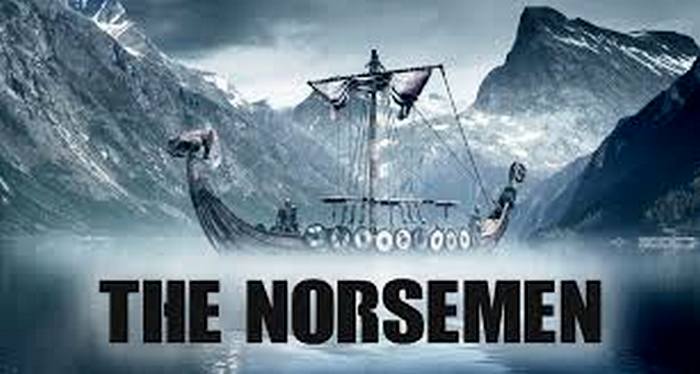
Blond men in boats
Thanks to chronicles and letters written by Christian holy men, perpetuated by modern books, cartoons and films, an enduring Viking stereotype is engrained in our collective cultural imagination: blond men in boats with beards and battle-axes, sailing slate-grey seas under northern skies. There is some truth in this. Technically speaking ‘viking’ simply means ‘raider’ (which is why we tend to use the broader term ‘Norse’ to describe medieval Scandinavian peoples, their culture and language). From the late eighth century onwards, the coastal and river monasteries of the British Isles and Western Europe were vulnerable to hit-and-run attacks from seaborne Scandinavians.
It is likely that, for most of us, the first image that springs to mind is not traders bumping over the desert sands to Baghdad on camelback or indeed of men of Norse descent out on the Russian steppes, worshipping the Slavic gods of thunder and lightning. It is also probably not bored Christian converts carving runic graffiti into the stone of Hagia Sophia, the magnificent basilica in Constantinople (now Istanbul). But, as is often the case, truth is far more interesting than fiction.
Over the centuries, Norse men and women set out from their homelands bound for distant lands. Through activities such as trading, raiding, fighting, colonising and settling, their travels took them west to Greenland and the edge of North America, north beyond the Arctic Circle, east down the Russian waterways and south to the Mediterranean and the Holy Land. The medieval world could be a brutal place and the Norse played their part in making it so. But they were cultural chameleons, adopting local habits, languages and religions.
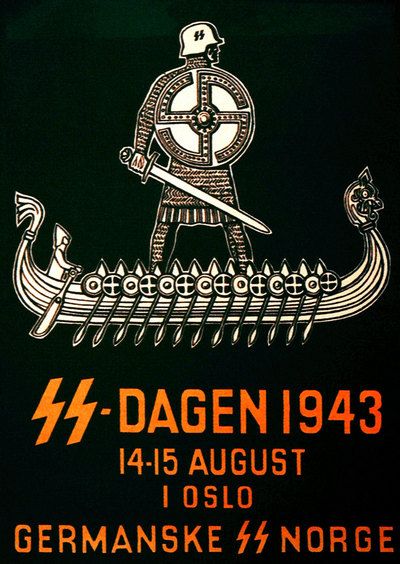
Waffen-SS propaganda poster to recruit Norwegian men during the Nazi occupation of Norway, 1943.
While the Norse raids on the British Isles are perhaps best known – the attack on the island monastery of Lindisfarne in 793 is often used as a convenient date for the start of the Viking Age – Western Europe also experienced its share of violence. The Royal Frankish Annals record pirate-infested waters at the edge of Charlemagne’s kingdom from around AD 800, probably Danish raiders. A few years later, a Danish king called Godfred laid waste to the northern regions of the Carolingian Empire. The scale of this activity grew, with the Seine, Loire, Elbe and Rhine acting as routes into the heart of Western Europe. The first siege of Paris in 845, saw 120 ships sail up the Seine. Reports stated that they defeated the king’s army and hanged 111 of his men as a sacrifice to Odin, before occupying the city.
Christian Converts
Over the years the Frankish rulers tried different tactics: paying Vikings off, converting them to Christianity, allying with their leaders, pitting them against each other, even ignoring them in the hope that they would go away. Finally, in 911, a Norwegian raider called Rollo was granted lands in north-west France in return for converting to Christianity and swearing loyalty to Charles the Simple, king of the West Franks. This region included a portion of the Seine, meaning that Charles had made himself a convenient Norse ‘plug’ to stop other northern pirates sailing up the river and attacking further inland.
The king had set a thief to catch a thief: Rollo would not want his newly acquired lands crawling with river-borne looters any more than the Franks did. Now he was Christian, he would not attack any monasteries. And, since he answered directly to the king, he was on his best behaviour. That, at least, was the idea. Before they settled into their new role, Rollo and his men changed allegiances a few times, raided the coastline and generally made nuisances of themselves. Despite his conversion to Christianity, Rollo is said to have sacrificed slaves to the pagan gods Odin and Thor on his deathbed, just in case. Old habits die hard.
Even so, it was not long before the immigrants known as Nordmanni (‘Northmen’) assimilated, marrying local women and speaking the local language. Despite the fact that the Norse were in the minority the region became known as Normannia (‘Land of the Northmen’), or as we know it today, Normandy. But evidence for the Norse cultural roots of the Normans is relatively scarce. Norse place names tend to be concentrated around the coast, where Scandinavian settlement was most concentrated. There is not much archaeological evidence to go on, which suggests that the newcomers were in the minority and did not take long to adopt Frankish material culture and burial practices. By the early 11th century, it would have been unusual to hear anyone local speaking the Norse language.

Age of the Conqueror
By the time William the Conqueror crossed the Channel to shatter Anglo-Saxon England in 1066, the Normans were Northmen only in name. But visual remnants of their cultural heritage are woven – literally – into the Bayeux Tapestry. One clue is the hairstyles that many of the Normans sport, shaved at the back and long at the front. Writing a few decades earlier in England, Aelfric of Eynsham had complained that the English were adopting a similar sort of Scandi-chic look, dressing like Danes and cutting their hair with ‘bare neck and blinded eyes’. Elsewhere in the tapestry, Normans hold up war banners depicting ravens, a design associated with the Norse rulers and warriors. The Norse were keen on ravens, not least because the pagan god Odin was said to be accompanied by two named Huginn (‘thought’) and Muninn (‘memory’). As carrion birds, ravens were also emblems of corpses and battles and, in Norse poetry, ravens are described hovering over the corpses of warriors and feasting on their flesh. It would have been appropriate to march into battle with images of ravens fluttering above the army – a reminder to their enemies of what awaited them.
The Norse connection to the Normans is well known. But, in terms of Scandinavian cultural assimilation, what is even more remarkable about the events of 1066 is that all three major players were of Nordic descent. The first casualty was Harald Hardrada, killed by Harold Godwinson at the Battle of Stamford Bridge just outside York. As King of Norway, his Scandinavian credentials were well established. Leading the Normans, William the Conqueror was the great-great-great-grandson of Rollo, the Norse-raider-cum-royal-vassal who was given Normandy. Even Harold Godwinson, the last Anglo-Saxon king of England, was of Scandinavian heritage: his mother was Gytha, daughter of the Danish nobleman Thorgil Sprakling (‘strut-leg’). However the battle had transpired, a king of Scandinavian descent would have ended up on the English throne.
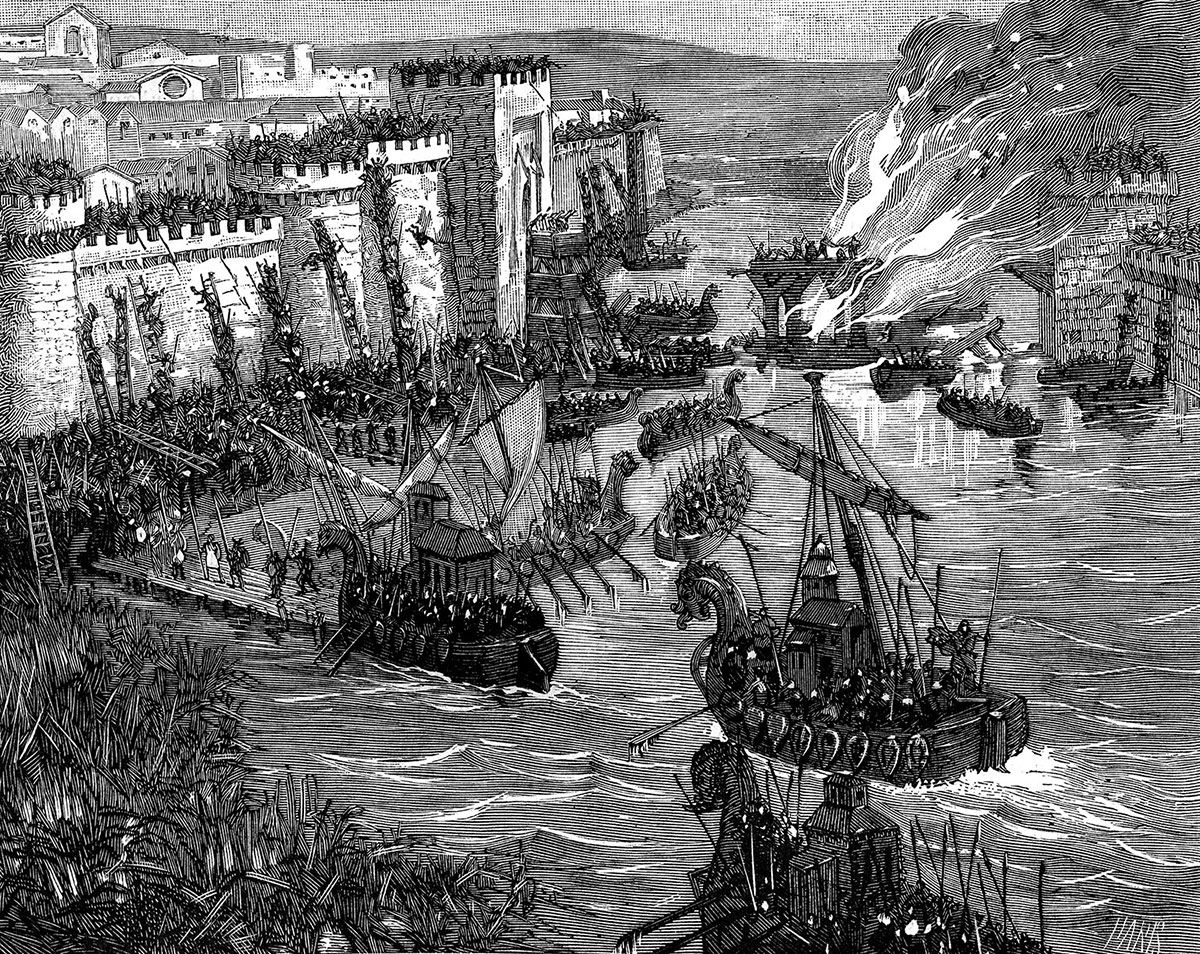
The Viking attack on Paris, 885, unknown artist, c.1882-84
The Nordic cultural and political influence on the British Isles was substantial. Off the northern coast of Scotland, the Northern Isles of Orkney and Shetland were under Norse rule until the 15th century. For hundreds of years afterwards, a form of Old Norse – Norn – was spoken in the islands. The Norse heritage is still visible in the landscape, in everything from place names, such as Kirkwall (kirkjuvágr, ‘church bay’), Twatt (þveit, ‘cleared piece of land’), and any island ending in ‘-ay’ (ey, ‘island’), to runic graffiti carved onto prehistoric cairns and stone circles. Before the Norse arrived, the Northern Isles had been occupied by the Picts, but evidence for cultural assimilation of the sort we see in Northern France is limited. Were they simply wiped out, or did the Norse come to dominate the socio-cultural landscape so completely that little evidence of other inhabitants survived?
Elsewhere in the British Isles, the situation was more fluid. Today the Isle of Man might seem rather remote, geographically, but for the Norse, with their superior ship technology, Man lay at the centre of the waters that connected England, Ireland, Scotland and Wales. It is hardly surprising that Scandinavians chose to settle there, but they did not wipe out the pre-existing population. Stone sculptures and crosses dotted across the island testify to the cultural and religious mix of the island’s Viking Age inhabitants, incorporating Celtic and Norse names as well as Christian and pagan imagery. Some depict stories from Norse mythology: Sigurd the dragon-slayer roasting the heart of the dragon Fafnir, or the one-eyed god Odin being swallowed by the wolf Fenrir at Ragnarok, the doom of the gods. But some stones also include Christian crosses, while others mix languages and scripts: Celtic names written in Norse runes, or stones with both Norse runes and Celtic ogham inscriptions.
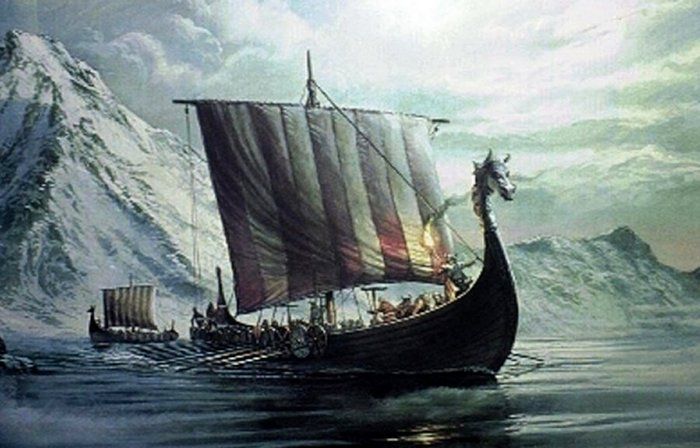
Viking Age activity in England began with sporadic raids at the end of the eighth century. Settlement began decades later, following the arrival of the ‘Heathen Army’ in 865. By the end of the ninth century, much of northern and eastern England was controlled by Scandinavians, an area that later became known as the Danelaw. But despite a concentration of place names that betray their Norse origins (‘by’ is a farm, ‘thorpe’ is a village or farmstead, ‘thwaite’ is a cleared area of land), there is not much other evidence for long-term Norse cultural dominance.
Once they started bringing over their wives and children – or forming relationships with local women – Norse concerns would have been more about keeping their farms and families safe, rather than looting and battling. Recent archaeological studies suggest that female immigrants expressed their Scandinavian heritage through jewellery they had brought with them, which may have once belonged to their mothers or grandmothers. These were not particularly high status, but were rich with emotional and cultural worth.
Often incomers were very good at adapting to the local social landscape and creating hybrid identities. When Alfred the Great defeated the Danish leader Guthrum in 878, he granted him the kingdom of East Anglia. One condition was that he convert to Christianity. At his baptism Guthrum adopted an Anglo-Saxon name and ruled as Æthelstan II. The silver pennies issued during his reign are Anglo-Saxon and Christian in style, imitating those produced in Alfred’s own kingdom. Coins from the Danelaw often include Christian symbols and inscriptions and many feature both the name of a Norse ruler and an Anglo-Saxon moneyer. Coins issued at St Peter in York depict an image of Thor’s hammer along with the name of St Peter, reflecting the cultural and religious hybridity of the time. We see similar ambiguity in a Viking Age smith’s mould from Denmark, which could forge both Christian crosses and Thor’s hammers depending on the religion of the customer.
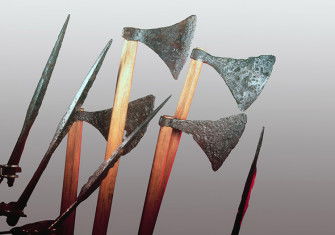
Magic, Medicine and the Viking Way of War
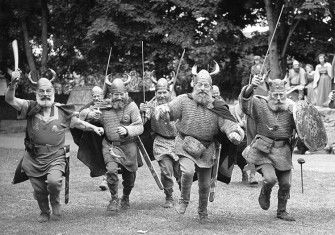
Barbaric Beauty
When it came to matters of cold hard cash, the Norse could be remarkably pragmatic with their cultural heritage and religious beliefs. Pagan Norse traders would often be prime-signed, a pre-baptism ritual – or ‘baptism lite’ – that meant Christians were allowed to trade with them. Others were utterly shameless when it came to their religious affinities. Writing in the 880s, the Frankish scholar Notker the Stammerer describes an event that took place during the reign of Louis the Pious, Charlemagne’s son.
Every year Danes would arrive demanding to be baptised, not because of their piety but because of the free gifts that accompanied the ceremony: expensive clothes, baptismal robes and weapons. On one occasion no fewer than 50 Danes turned up. Louis had to cut up some old shirts to use as robes. When the officials reached one elderly Dane, he was unimpressed: ‘I have gone through this washing business here twenty times already, and I have been dressed in excellent clothes of perfect whiteness; but a sack like this is more fit for swineherds than for soldiers’.
Rise of the Rus
It was not just the Norse in Western Europe and the British Isles who displayed such cultural – not to mention moral – flexibility. To the east, the Russian rivers were home to a people called the Rus, the people who gave Russia its name (meaning ‘Land of the Rus’). A ninth-century Arab writer called Ibn Khordadbeh, the caliph’s spymaster, described how Rus traders took their merchandise to Baghdad on camelback. Once inside they pretended to be Christian, presumably because it gave them a business advantage (even if it meant they had to pay tax like the Christians). Another Arabic account described how the Rus attacked settlements on the Caspian Sea in 913: ‘The Rus spilled rivers of blood, seized women and children and property, raided and everywhere destroyed and burned.’
If this seems reminiscent of the early Viking attacks on the British Isles, it is no coincidence. The Rus were descended from Norse traders – mostly Swedes – who had set off east, crossed the Baltic Sea and sailed up the waterways of the Russian steppes. In 862, according to later accounts, a Norse prince called Rurik was said to have established his base in Novgorod. In time, the centre of power shifted south to Kiev. As Rurik’s descendants consolidated their position in the region, they formed a state that came to be known as Kievan Rus.
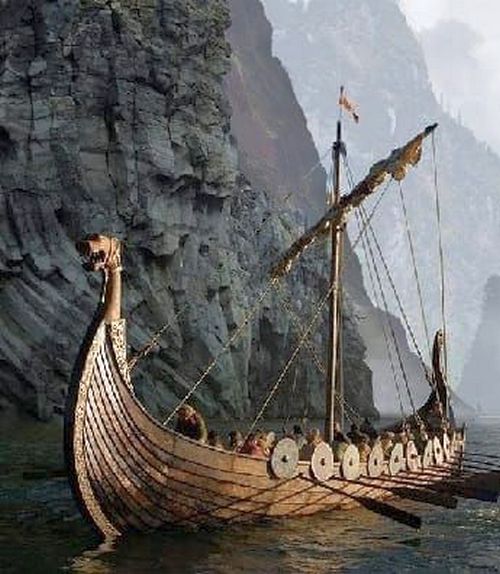
The Rus, too, operated in a multicultural world. In fact, the 10th-century Persian explorer and geographer Ibn Rustah described the Rus as being particularly friendly towards foreigners and strangers seeking refuge. As with the Vikings in France and England, the Rus were the minority and the further they ventured up the Russian rivers, the more they found themselves in a landscape dominated by Slavic tribes. There would certainly have been Rus of Scandinavian extraction, but also non-Scandinavians in the mix. It is not always easy to work out how people from the past defined themselves culturally, but sometimes they leave clues. One example is the names they give their children.
From 912 to 945, the ruler of Kievan Rus was Igor. His wife was Olga, a formidable individual who would later visit bloody revenge on her husband’s murderers. Their names may seem Russian, but actually they are Norse in origin: Igor comes from ‘Ivarr’ or ‘Yngvarr’ and Olga comes from ‘Helga’. But the pair called their son Svyatoslav, a decidedly Slavic name. In the decades since Igor and Helga were themselves named, something seems to have shifted in terms of the dominant cultural affiliation. When he came to power, Svyatoslav styled himself as a typical Slavic ruler, worshipping the Slavic gods Perun (god of thunder and lightning) and Volos (god of flocks). Later sources describe how he was killed by enemies who did him the great honour of covering his skull in gold and using it as a drinking vessel.
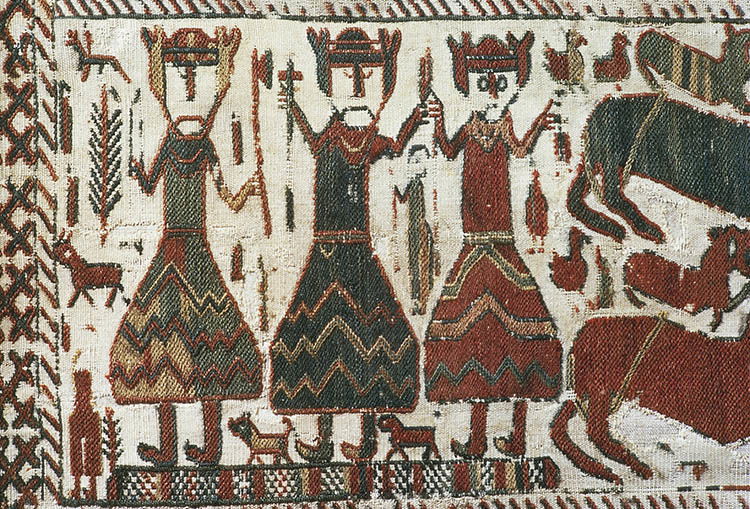
Detail from the Skogchurch Tapestry depicting the Norse Gods Odin, Thor and Freyr, Sweden, 12th century.
This sort of cultural fluidity has posed historians numerous problems but also allowed for selective readings of the past. During the Soviet era, Russian historians were keen to play down the role of European Scandinavians in the founding of their nation, in favour of the Slavic tribes. Adolf Hitler exacerbated the situation, declaring over dinner that ‘unless other peoples, beginning with the Vikings, had imported some rudiments of organisation into Russian humanity, the Russians would still be living like rabbits’. As is so often the case, the historical truth is probably somewhere in between.
Over time the Rus became more multicultural, more Slavic. Even so, links between Scandinavia and Russia were maintained. The Old Norse sagas – stories recorded in 13th-century Iceland but often looking back to the Viking Age – tell tales of Scandinavian kings who fled to the Kievan Rus court to escape their enemies. There is even one outlandish tale of two Russian princesses spirited away to supernatural lands ruled by nymphomaniac giant women (this may not be entirely accurate). Even Harald Hardrada, king of Norway until his death in 1066, had a Rus wife, Elisiv of Kiev. The sagas preserve poetry he composed for her before they married, mostly lamenting the fact that she did not seem to be particularly interested in him.
Not all Norse far-travellers were masters of cultural assimilation. For instance, when Norse hunters in Greenland discovered the country’s Inuit population in the far north, reports are not encouraging. A 12th-century text called The History of Norway states ominously:
Beyond the Greenlanders some little people have been found by hunters, who call them skraelings. Weapon wounds inflicted on them from which they will survive grow white without bleeding, but if they are mortal the blood hardly ceases to flow.
Bloody Feuds
It does not require a great deal imagination to guess how the hunters discovered the bleeding habits of these people. Oral stories collected from Greenlanders in the 19th century also hint at a complex, sometimes violent relationship between the Inuit and a mysterious people they called Kavdlunait (‘foreigners’), who may be the Norse. In one story, a bloody feud ends with an Inuit chopping off the arm of a Kavdlunait. In another, a group of Kavdlunait attack and butcher a family: the two little daughters are told to throw themselves into the sea rather than let the foreigners capture them. Another cheerier story describes cordial relations between the two groups, with fast friendships formed, friendly competitions and mutual language learning.
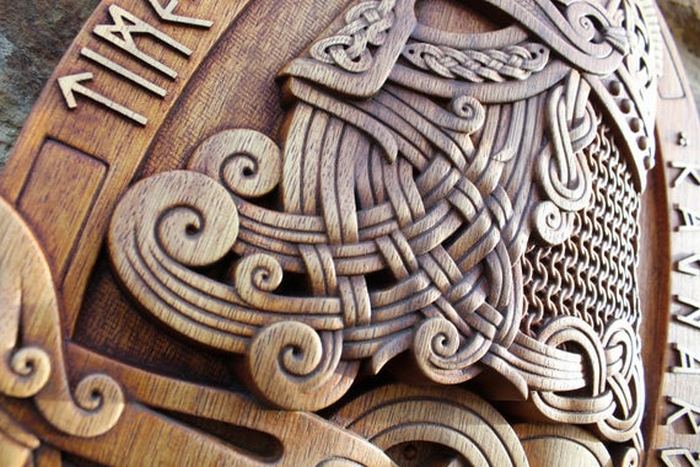
Further west, on the edge of the North American continent, the sagas report that Norse explorers encountered locals whom they also called skraelings. Diplomatic relations got off to a promising start, with the two groups trading goods such as furs and cloth, but it did not take long before the bloodshed began. Perhaps the clue to what went wrong lies in the name the Norse gave to the inhabitants of both Greenland and America – skraelingar – a derogatory term roughly translated as ‘wretched ones’. Offensive names and cultural stereotypes are precisely the sort of building blocks used to erect invisible walls between people and groups: the Norse certainly were not immune to this sort of thinking and categorisation.
Even so, forget dark ideologies that misrepresent and misuse Nordic culture past and present. Forget popular images of the Vikings based on cartoons, television shows and Hollywood films. The reality of Viking Age history is far broader, far deeper and far more profound than this. They were violent, brutal warriors intent on expansion and slippery politicians, too. They were also masters of cultural adaptation and integration and this is where their enduring legacy lies.
Eleanor Rosamund Barraclough is Associate Professor of Medieval History and Literature at Durham University and author of Beyond the Northlands: Viking Voyages and the Old Norse Sagas (OUP, 2016). This article originally appeared in the April 2018 issue of History Today.
WHO and WHAT is behind it all ? : >
The bottom line is for the people to regain their original, moral principles, which have intentionally been watered out over the past generations by our press, TV, and other media owned by the Illuminati/Bilderberger Group, corrupting our morals by making misbehavior acceptable to our society. Only in this way shall we conquer this oncoming wave of evil.
Commentary:
Administrator
All articles contained in Human-Synthesis are freely available and collected from the Internet. The interpretation of the contents is left to the readers and do not necessarily represent the views of the Administrator. Disclaimer: The contents of this article are of sole responsibility of the author(s). Human-Synthesis will not be responsible for any inaccurate or incorrect statement in this article. Human-Synthesis grants permission to cross-post original Human-Synthesis articles on community internet sites as long as the text & title are not modified.
The source and the author's copyright must be displayed. For publication of Human-Synthesis articles in print or other forms including commercial internet sites. Human-Synthesis contains copyrighted material the use of which has not always been specifically authorized by the copyright owner. We are making such material available to our readers under the provisions of "fair use" in an effort to advance a better understanding of political, economic and social issues. The material on this site is distributed without profit to those who have expressed a prior interest in receiving it for research and educational purposes. If you wish to use copyrighted material for purposes other than "fair use" you must request permission from the copyright owner.